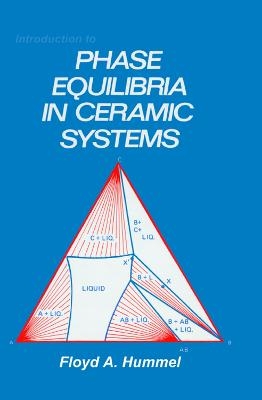
Introduction to Phase Equilibria in Ceramic Systems
CRC Press (Verlag)
978-0-367-45183-7 (ISBN)
Written by a leading practitioner and teacher in the field of ceramic science and engineering, this outstanding text provides advanced undergraduate- and graduate-level students with a comprehensive, up-to-date Introduction to Phase Equilibria in Ceramic Systems. Building upon a concise definition of the phase rule, the book logically proceeds from one- and two-component systems through increasingly complex systems, enabling students to utilize the phase rule in real applications. Unique because of its emphasis on phase diagrams, timely because of the rising importance of ceramic applications, practical because of its pedagogical approach, Introduction to Phase Equilibria in Ceramic Systems offers end-of-chapter review problems, extensive reading lists, a solid thermodynamic foundation and clear perspectives on the special properties of ceramics as compared to metals.This authoritative volume fills a broad gap in the literature, helping undergraduate- and graduate-level students of ceramic engineering and materials science to approach this demanding subject in a rational, confident fashion. In addition, Introduction to Phase Equilibria in Ceramic Systems serves as a valuable supplement to undergraduate-level metallurgy programs.
Hummel,
PREFACE -- 1. INTRODUCTION AND DEFINITIONS -- I. Historical -- II. Literature Sources -- III. Statement of the Phase Rule and Definitions -- Problems -- References -- Reading List on Phase Equilibria -- 2. THE ONE COMPONENT SYSTEM -- I. Thermodynamic Basis of the Phase Diagram -- II. Application of the Phase Rule to the System H2 0 at Ordinary Temperature and Pressure -- III. Le Chatelier’s Principle and the Clausius-Clapeyron Equation -- IV. Metastability and Non-Equilibrium -- V. The Bridgman Ice Diagram and the Importance of -- Pressure; Polymorphism of Solids; Phase Diagram—Property Diagram -- VI. Examples of Real Systems VII. Summary -- Problems -- References -- 3. THE TWO COMPONENT SYSTEM -- I. Introduction -- II. The Binary Eutectic System -- III. Intermediate Compounds -- IV. Isothermal Analysis; Isothermal Evaporation -- V. Metastable Relationships in Simple Binary Systems -- VI. Complete or Continuous Solid Solution -- VII. Partial Solid Solution -- VIII. Phase Transitions in the End Members or Intermediate Solid Solutions; Combinations of Continuous and Partial Solid Solution; Exsolution -- IX. Complex Solid Solution Diagrams -- X. Liquid Immiscibility -- XI. Real Oxide Systems -- XII. Fluoride Model Systems Problems References -- 4. EXPERIMENTAL METHODS OF CONSTRUCTING PHASE DIAGRAMS -- I. Introduction -- II. Major Factors in Experimental Methods -- III. Glass Forming Systems vs. Non-Glass Forming Systems -- IV. Special Techniques -- V. Discussion and Evaluation of Experimental Pro-cedures on Real Systems -- VI. Thermodynamics and Computer Calculation -- Appendix A -- Appendix B References on High Pressure Methods and Materials -- Suggested Class Disscussions Which Can Enlarge the Understanding of Experimental Techniques -- References -- 5. TERNARY SYSTEMS W ITHOUT SOLID SOLUTION -- I. Introduction -- II. Isoplethal Analysis; The Equilibrium Crystallization Path in a Simple Eutectic Type System; Use of the Lever Rule -- III. Hie Influence of Binary Compounds on the Ternary System; Joins and Alkemades Lines; Composition or Compatibility Triangles; Crystallization Paths -- IV. The Influence of Ternary Compounds on the Ternary System; Crystallization Paths -- V. Polymorphism or Phase Transformations in Ternary Systems Without Solid Solution -- VI. Review and Summary of Factois Which Must Be Considered During Isoplethal Analyses -- VII. Liquid Immiscibility -- VIII. Isothermal Sections in Aqueous Systems; Isothermal Evaporation -- IX. Isothermal Sections in Ternary Oxide Systems -- X. Vertical Sections in Ternary Oxide Systems -- XI. Complex Ternary Systems -- XII. Real Ternary Systems Problems -- 6. NON-EQUILIBRIUM IN CERAMIC SYSTEMS -- I. General -- II. One Component Systems -- III. Two Component Systems -- IV. Three Component Systems -- Problems -- References -- 7. SOLID SOLUTION IN TERNARY SYSTEMS -- I. Introduction -- II. The Complete Solid Solution System; The Equilibrium Ciystallization Path -- III. Complete Solid Solution in One Binary System Combined With Two Simple Eutectic Systems; Isothermal Planes; Three Phase Boundary Lines; Quantitative Analysis of Crystallization Path (Isoplethal Analysis); Three Phase Triangles -- IV. Ternary Solid Solutions Crystallizing From Ternary Liquids; One Complete Solid Solution System, Two Partial Solid Solution Systems; Crystallization Path; Isothermal and Vertical Sections -- V. Solid Solution Systems With Three Phase Equilibria -- VI. Solid Solution Systems With Four Phase Equilibria -- VII. Additional Basic Solid Solution Systems -- VIII. Real Systems with Intermediate Compounds and Solid Solutions -- Problems -- References -- 8. QUATERNARY AND MULTICOMPONENT SYSTEMS -- I. Introduction; Quaternary Systems Without Solid Solution -- II. Crystallization Path in a Simple Quaternary Eutectic Type System; Isoplethal Analysis -- III. Method of Representing Relationships Between Quaternary Invariant Points -- IV. Solid Models of Real Quaternary Systems -- V. Solid Solution in Quaternary Systems VI. Multicomponent Systems -- References -- INDEX.
| Erscheinungsdatum | 15.01.2021 |
|---|---|
| Verlagsort | London |
| Sprache | englisch |
| Maße | 156 x 234 mm |
| Gewicht | 453 g |
| Themenwelt | Naturwissenschaften ► Biologie |
| Naturwissenschaften ► Chemie ► Physikalische Chemie | |
| ISBN-10 | 0-367-45183-2 / 0367451832 |
| ISBN-13 | 978-0-367-45183-7 / 9780367451837 |
| Zustand | Neuware |
| Haben Sie eine Frage zum Produkt? |
aus dem Bereich


